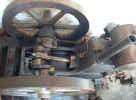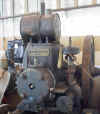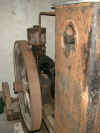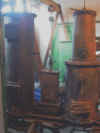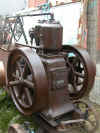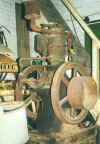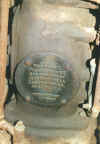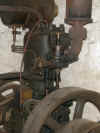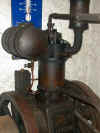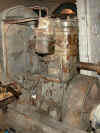(Updated 23 november 2002)
A few words of explanation about the tons of scrap iron I found lying about all over the place ...
H.S.C.S
HSCS (Hofherr Schrantz Clayton Shuttleworth)
HSCS were building tractors, but also engines, this is
type MEB number 4128, built probably in about 1925.
The most recent type of Benz engine seems to have been
inspired by this design ?
Open crank, rotating magneto. Mechanically quite unusual. HSCS engines are quite
rare.
I now also found a HSCS MEL engine, bigger than the MEB, date probably about 1911. A very interesting engine with vertical flyball regulator. After some checking, and a bit of adjusting, the engine could be persuaded to run, using the carburetor from the MEB, because unfortunately, the carburettor is missing ...
Could you please help
me with documentation about HSCS engines (or tractors) ?
Thanks in advance !
Langen & Wolf
Langen & Wolf (Austria)
Langen & Wolf was one of the first companies to have a
licence agreement with Otto to build Otto-Langen four-stroke gas engines, from the very
first type with crosshead and flame carrier ignition.
The company was established in Vienna (= Viden) by Langen himself, in 1872, and
over the years became quite important, with subsidiaries in for example Germany and
Italy (Milano).
Otto engines of that period are all quite similar, a noteworthy feature being the typical hanging flyball regulator..
Other manufacturers of this engine were, of course, Gasmotorenfabrik Deutz, but also, for example, the Compagnie Française des Moteurs Otto (France) and Fetu-Defize (Belgium)
Very few Langen & Wolf engines survive, probably not more than 5, and this is one of them : with hot tube ignition, probably type E3, probably 4 HP, flywheel diameter about 1m40, estimated year of manufacture : 1898.
Could you please help
me with documentation about this engine (Langen & Wolf, or Deutz, any
manufacturer), and on Langen & Wolf in general ? Or do you know where such
an engine can be seen ? Thanks in advance !
Lorenz
Lorenz was a very successful company, founded in 1887 by Ignac Lorenz, and
continued to exist until 1948, when production was stopped by communism. Their engines were very modern and reliable
for their time, the design remained virtually identical from engine No 1500 up to maybe engine
No 20000
Half-open crankcase (open sides), hit/miss, magneto with
striking lever, sideshaft. Brass carburetor. The photograph shows clearly what a
splendid engine an approx 1925 model is after restoration.
A few Lorenz engines FOR SALE
: jan_deklerck@hotmail.com
Lorenz no. 962, built in about 1920. Open crank, low tension.
This is probably the oldest Lorenz, and the only low-tension one, you will
ever see, but is really in a quite sorry condition : rusty, parts missing, ...
But if one comes across an engine that is of such historical interest, it is all
worthwhile, of course.
I have a second open crank Lorenz, no 4888, high tension. Open crank Lorenz engines are really quite rare.
Lorenz 4HP no. 1796, built in about 1920. This engine is a quite early
Lorenz.
(most collected Lorenz engines have engine numbers over 10000)
A few characteristics give away it's old age :
carburetor on top of the cylinder, valves on one side, at an angle of 90 º to
each other, square foot on the fuel tank, a.s.o.
His twin is FOR SALE : jan_deklerck@hotmail.com
Identification plate and logo (on the cooling tank) for an old-style Lorenz motor,
approx 1925.
Some Lorenz engines have a coupling in the pulley, but this engine style is
rarely seen.
Contrary to the smaller engines, the bigger types remained fully open crank, but very few of these are known to survive.
The later engines were petrol-paraffin. Although these engines still very
much resemble their other brothers,
they can readily be recognized due to their modern style carburetor, volume
governing, and a fuel tank divided into 2 compartments, each with its own tap.
Restored, this becomes a surprisingly handsome engine, at a very affordable
price.
The bigger engines from that period were also half-open crank.
Later still, Lorenz started building diesel engines, four-stroke, but also
two-stroke. The latter resemble very much the Belgian Moes
engines.
Original Info
Original Info Original Info
(Index)
Benz
Benz (Trebic, Morava) of (Trebitsch, Mahren) Czech Republic
Benz is the most wanted somewhat affordable Czech engine.
It has all features we like in an engine : open
crank, hit-miss, magneto with striking lever, sideshaft, on original trolley,
elegant, relatevely uncommon (only about 7000 Benz machines have been built, the
numbering includes the threshing machines built by Benz)
Most collected Benz engines have engine nos over 2500.
(Sorry for the poor quality of the photos : the lighting conditions were difficult)
The earliest Benz engines had low-tension ignition (rare, hardly
affordable).
I was lucky to find one of these, number 383, manufactured probably between 1908
- 1912.
And in addition it is a producer-gas engine, and it came complete with the gas
producer plant, in an exceptionally good condition.
The engine was mounted in a workshop, and was therefore not in portable form.
To make it transportable, I mounted the engine and the gas producer plant on
trolleys.
Portable Benz engines are a common sight, but gas producer plants have also been
offered in portable form.
The engine is not hit-miss, but regulates the time the inlet valve remains open.
Hit-miss regulation would produce a very erratic draught through the gas
producer plant, this is obviated by the more elaborate regulator found on this
engine.
This engine could be the largest surviving Benz engine : flywheel diameter 110
cm.
Among several differences to later engines, the flat topped cylinder head is
noteworthy.
The inlet is not fitted to the cylinder head, but to the valve body. This made for a simpler cylinder head casting.
A Benz having this type of cylinder head is extremely rare.
This cylinder head design was also used in very early Klima engines.
Later, the choice was offered between low- and high tension, the
rest of the engine being identical for both versions (e.g. my nr. 901, 5hp, high tension option).
Because of this possible choice, the sparking plug was mounted in an exchangeable
flange .
The inlet valve drive still enables a magneto position that makes it possible to
use a simple rod to work the igniter.
Still later, only high tension was available, doing away with the flange. The magneto is positioned further backwards, enabling a straight inlet valve drive. It should also be noted that the steering front wheels are now situated under the cooling tank. At that time the engines could be had in 2 versions, light and heavy. For example, you will see the 4/5HPwith flywheels of 66cm diameter and a weight of approx 350kg, and with flywheels of 75cm diameter, bigger cylinder size, and a weight of approx 650 kg, but running at lower RPM. Later variations concern the valve mechanism, connecting rod lubrication, pressure lubrication for the piston, cast iron cover over the crankcase, a.s.o.
Benz FOR SALE : jan_deklerck@hotmail.com
The last design introduced by Benz was of a completely different design, smaller, and it is quite rare, only about 200 have been built. (e.g. my nr. 7120, 3-4 hp, approx 1936). This engine had the pressure lubrication for the piston, using a little pump topped by an oiler, a system also to be found on the very early Benz engines. Surprisingly, the engine was still open crank, using the same casting as the older style engine.
Original Info
Original Info
(Index)
Kokora
Eduard Kokora in Prerau (Czech Republic)
Kokora was building steam engines,
threshing sets, engines, and all kinds of implements : straw cutters, straw
elevators, horse gins, chaff blowers, plows, harrows, seeders, a.s.o.
This Kokora engine dates from approx 1915. It is a very characteristic Czech
threshing engine, a sole survivor of the type, 1500 kg for only 5hp !
The cooling tank is not original, probably some overheating problems were
experienced : the engine now has screen cooling and forced circulation. Originally it had thermo-siphon natural circulation, as most Czech engines have.
The low tension ignition was also replaced
by high tension, possibly because that was considered to be more reliable.
Original Info
Original Info
(Index)
Klima
Klima (Czech Republic)
(Sorry for the poor quality of the photos : the lighting conditions were difficult)
Klima is quite rare, and one being fully open crank (no cast iron cover)
certainly is.
(Klima is always open crank, but the later models had a tightly fitting cast
iron cover carrying the oiler, so the engine normally cannot run for prolonged
periods with the cover removed).
But this is a very early one, having a flat topped cylinder head.
The inlet valve body is not fitted to the cylinder head, but to an intermediate
piece to which the carburettor (fuel mixer really) is bolted.
This made for a simpler cylinder head casting.
A Klima having this type of cylinder head is extremely rare.
The photographs do not do the engine justice, it is in quite good condition
really.
This cylinder head design was also used in very early Benz
engines.
Klima FOR SALE : jan_deklerck@hotmail.com
KK Koloc
KK Koloc picka a spol, Kosmonosy (Czech Republic)
This is a very unusual engine, not at all typical for Czech engines of this
size (1100 kg)
It has evaporater cooling instead of the almost universal tank cooling.
The flywheels are solid, which give the engine a very massive look.
But all castings have the same heavy appearance.
The engine is open crank, and has low tension ignition, built about 1910.
It is believed to be the only surviving Koloc engine..
In completely original condition. But I reserved 2 spoke flywheels for it, to
make it somewhat more attractive ...
Slavia
Slavia (Czech Republic)
Slavia was a very succesful company, with modern engines .
De older collected Slavia engines are big vertical petrol engines with side
valves.
They have volume speed regulation, and a high tension magneto with striking
lever.
These engines, dating from the end of the 1910's, are quite difficult to come
by.
The engine could be termed as a "Lister-lookalike", on an original
trolley with shapely cast iron wheels.
The forced cooling pumps the water over a cooling screen. (Claeys
had the same cooling sytem).
Slavia For Sale : jan_deklerck@hotmail.com
More recent engines are smaller and run at higher rpm.
Later Slavia also built diesel engines, mostly 2-stroke. They look very much like the Belgian Moes engines
An especially attractive feature of a Slavia engine is the delicate casting at the sides of the cooling screen : it displays the "Savia" name in elegant lettering.
Original Info
Original Info
(Index)
Little (Josef Odstrcil)
"Little"
Josef Odstrcil,
45
cm Ø, ±150kg, ±1920 ![]()
![]()
![]()
![]()
![]()
![]()
This is an exceptionally rare engine. Only two of this make are known.
This is one of them, an aircooled engine (the other surviving engine is
watercooled).
Apparently the engine design bases heavily on the International Tom Thumb (see
the Info on the "engines"
page).
Quite a few "International" engines were imported to that part of
Europe before WW1, and since they were successful, it cannot be a surprise that
a smaller company copied the design (just as REMAR, another Czech company,
copied the Amanco Chore Boy).
The engine is not just a copy, several design improvements were implemented, one
of them being the bearing for the intermediate magneto driving gear, which was
very fragile in the Tom Thumb design.
![]()
![]()
Een zeer zeldzame motor, er zijn nog slechts 2 Little motoren bekend (de andere
is watergekoeld).
De motor lijkt zeer sterk op een International Tom Thumb (zie de beschrijving
op de "motoren" pagina).
Voor wereldoorlog 1 zijn heel wat International motoren ingevoerd in dat deel
van de wereld, en omdat ze zeer betrouwbaar waren, hoeft het dus niemand te
verwonderen dat een kleine firma een beetje plagiaat pleegde (net als REMAR, een
andere Tjechische firma, die de Amanco Chore Boy copieerde).
Maar de "Little" was geen pure copie, er waren verschillende
technische verbeteringen, zoals bijvoorbeeld een verbeterde bevestiging van het
tussentandwiel voor de aandrijving van de magneto. Bij de Tom Thumb was dit een
zeer fragiel en onverstandig ontworpen gietstuk.
![]()
Ein extrem seltene Motor, nur noch 2 Little Motoren sind bekannt (der zweite hat
Wasserkühlung).
Der Motor ist einen International Tom Thumb sehr ähnlich (sehe die Beschreibung
auf die "Motoren" Seite).
Vor den ersten Weltkrieg wurden eine Menge International Motoren in diesen Teil
Europas importiert, und weil sie sehr zuverlässig waren, darf es keinen
wundern, das eine kleine Firma wie Josef Odstrcil einen International nachbaute
(wie auch REMAR, eine andere Tschechische Firma, den Amanco Chore Boy
nachbaute).
Aber den "Little" war doch gegenüber den Tom Thumb um einiges
verbessert.
Zum Beispiel die Lagerung des Zwischenzahnrads zum Magnetantrieb war viel
stabiler, beim Tom Thumb ist diese sehr zerbrechlich.
![]()
Un moteur tres rare : seulement 2 moteurs "Little" sont connus (le
deuxieme a le refroidissement par eau).
Le moteur ressemble beaucoup un moteur International "Tom Thumb" (voir
la description sur la page "moteurs").
jan_deklerck@hotmail.com (Index)
International Harvester
International Famous "Nonpareil" (USA), 1917
This type of engine is not a common sight, and even then, it is rarely equipped
with the huge low tension magneto this one is equipped with.
And it should not always be big : I found this now : an International Tom Thumb, not an engine you see every day either !
Claeys
Leon Claeys from Zedelghem, Belgium
Claeys was quite well known for
his very reliable engines, most of them being sold in portable form. The older
diesels diesels (1930's) in many cases found a job as a pure stationary engine,
de jlater, smaller diesels could only be bought for that purpose.
De older style engines (diesel, hot bulb crude oil, petrol) in many cases were
sold with a clutch in the pulley, an optional extra.
The photo shows a Claeys (Belgie) hot bulb engine seeing daylight again for
the first time since 30 years, somewhere near Antwerpen, the original owner
kisses it goodbye. A few weeks later the engine was first shown (not without all
kinds of minor problems) in Ardingly (UK).
Another few weeks later it ran in Marke (Belgium), at the Nuttin engine-show,
and in Lauwe (Belgium), where relatives from the original owner came to wonder
what granddads machine was like after return from oblivion
Claeys hot bulb engines are very much sought after, especially by people from
Holland ....
The Home Page shows the engine being used, end of the 1930's.
A Claeys (Belgie) petrol engine of approx 1917.
Only very few Claeys petrol engines are know to survive.
A Claeys Diesel engine. A bit crudely built, but they simply
lasted. So quite a few still exist, some on original trolleys, and some used as
a fully stationary engine.
Original Info
Original Info Original Info
Original Info
(Index)
La Fourmi
La Fourmi (Kortrijk, Belgium)
Built approx 1910. Open crank town gas engine, low tension.
La Fourmi was built in Kortrijk, and is very collectable. About 15 La Fourmi
engines are known to exist.
This engine is the biggest surviving La Fourmi, the only one of its kind.
These bigger types of La Fourmi engines have a very characteristic volume
governing system, using a toothed lever, the regulator in function of the engine
speed then selects a tooth, so dictating the amount the valve opens.
Another unique engine is the La Fourmi "portable", fully original,
with a crop spraying waterpump, the drive of which is partly incorporated in the
engine castings.This engine has a rather classic hit-miss regulator, operating a
slide valve.
Ruston
Ruston (Engeland) PR size 2, approx 1935
Ruston is more known for their larger stationary engines, but this is a smaller
open crank petrol engine.
I plan to use the engine as a starting aid for a bigger Ruston HR4 stationary Diesel
of 1935, by means of a friction wheel in contact with the flywheel.
The Ruston HR4 is a typical stationary engine for industrial use, this one drove a flax mill. It wa sbought second hand to replace a Bollinckx steam engine. The photo shows my son Piet wondering if we will ever succeed in freeing the keys securing the flywheel. Eventually they came out. That was a relief, since the engine had to be brought out through a corridor only about 1m25 wide.
Jongere Ruston PB
TE KOOP
: jan_deklerck@hotmail.com
Wichterle
Franz Wichterle founded his company in 1878.
The engine shown was built in approx 1913, in that year the company employed 1050
people.
Wichterle was then building steam engines, mainly portables, threshing machines,
and petrol engines.
At the turn of the century Wichterle had gained an impressive number of
medals at shows, in Czechoslovakia, but also in Russia and Paris.
Wichterle engines are quite rare, and quite probably this engine is the only one
of its type surviving.
This engine, and in fact almost all Wichterle engines (except the cheaper "high
speed" engines), are equipped with a clutch in the pulley.
The carburetor seems to complicated for a petrol engine, and since the air
intake is around the exhaust, one could think this is a paraffin engine. This is
not the case, it is a petrol engine, the period documentation describes this
system, claiming a very low petrol consumption..
Original Info
Original Info
(Index)
Wichterle-Kovarik
Wichterle-Kovarik (WIKOV) Czech Republic
Mid 1920's the companies Wichterle and Kovarik merged, to become the company Wichterle-Kovarik (later shortened to WIKOV). The company was very successful, and became famous for their "Robot" engine, a very simple, affordable and reliable petrol-paraffin engine. Many of these were sold. But they are best known for the luxury cars they produced.
My engine is reputed to be the first type of engine designed jointly by Wichterle-Kovarik. It is the last type of engine to have a brass identification plate, the later engines had all information painted on the engines in fairly big lettering. Contrary to the Robot engines (this brand name eventually became better known than the company name Wikov), the Wichterle-Kovarik engine is quite rare. My engine is in a sorry state, with some parts missing, but a genuine collector should not be stopped by such minor problems, don't you think ? An incomplete, somewhat younger engine, but in better condition, and on its original trolley, will supply the necessary parts.
Originele Info
Originele Info
(Index)
Fairbanks-Morse
This will not be the first Fairbanks-Morse Z engine you see.
But this model was built during only 1 year: in 1918.
Very distinctive is the small Sumter low tension magneto built as one assembly
with the igniter.
This is a smaller, more recent Fairbanks Morse Z engine. Portable in the real sense of the word ...
Amanco
Amanco (Associated Manufacturers Company) needs no introduction, every show
displays several of them usually.
Low tension, hit-miss, open crank : a very attractive engine, both to the eyes
and to the ears !
At a show, an Amanco Chore Boy was for sale, but everyone looked at it very suspiciously : it had no identification
plate, and although it was similar to an
Amanco, several features were quite different. An Amanco copied ? (Quite a lot
of companies copied the Amanco design, for example Remar in Czechoslovakia did).
But this is indeed an original Amanco, and a very early one at that : the magneto drive is
parallel to the crankshaft, and the water hopper is a separate casting, with a
rectangular (not oval) opening, the edges being rounded inwards. Probably built in 1912
or 1913. Since nobody wanted the engine, it was a good buy. It better was,
because the crankshaft needed a lot of persuasion to reassume its original shape
... The engine being seized, nobody noticed that the crankshaft was bent, and
neither did I.
The engine was converted to high tension. I have the igniter for low tension,
but can anyone offer me a magneto ? Tall model, bronze body. A later style magneto
with zamak body might fit the bill eventually. Offers : jan_deklerck@hotmail.com.
Thanks in advance !
Junkers
Junkers is mainly known for its two-stroke diesel engines. (To us, that is.
Militaria collectors will know Junkers as the builders of the frightening StuKa
aircraft in WW2, and plumbers nowadays are installing Junkers water boilers).
A Junkers engine uses, in 1 cylinder, 3 pistons, and 3 connecting rods. The
engine has no valves, but ports in the cylinder.
The lower piston (rises for compression) opens and closes the exhaust ports, and
is driven by 1 connecting rod.
The middle piston (comes down during compression) opens and closes the inlet
ports, and is driven by 2 long slender connecting rods.
The top piston is bolted to the middle one, and works in a part of the cylinder
that has a larger bore, sealed by the cylinder head, and forming an air
compressor for the inlet air.
This type of engine was the first successful high speed diesel, dated early
1940's.
Not many Junkers engines are seen, but this type of engine was also built
by CLM in France (Compagnie Lilloise de Moteurs) using a Junkers license.
Quite a few CLM engines survive, in stationary form, or for vehicle propulsion,
an example being the Latil forest tractor.
CLM engines are recalcitrant starters, Junkers engines fire at once.
Moës
Moës (Waremme, Belgium)
Moes was one of the most successful diesel engine
manufacturers in Belgium.
The earlier Moës engines were two stroke hot bulb crude oil engines, and are very
collectionable.
The later engines look very much like the earlier ones, but are two-stroke
diesels (as is my Moes engine)

